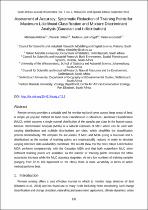 ResearchSpace
ResearchSpace
Assessment of accuracy: systematic reduction of training points for maximum likelihood classification and mixture discriminant analysis (Gaussian and t-distribution)
JavaScript is disabled for your browser. Some features of this site may not work without it.
- ResearchSpace
- →
- Research Publications/Outputs
- →
- Journal Articles
- →
- View Item
| dc.contributor.author |
Ritchie, Michaela C

|
|
| dc.contributor.author |
Debba, Pravesh

|
|
| dc.contributor.author |
Lück-Vogel, Melanie

|
|
| dc.contributor.author |
Goodall, V

|
|
| dc.date.accessioned | 2018-10-01T10:13:00Z | |
| dc.date.available | 2018-10-01T10:13:00Z | |
| dc.date.issued | 2018-09 | |
| dc.identifier.citation | Ritchie, M.C. et al. 2018. Assessment of accuracy: systematic reduction of training points for maximum likelihood classification and mixture discriminant analysis (Gaussian and t-distribution). South African Journal of Geomatics, vol. 7(2): 132-146 | en_US |
| dc.identifier.issn | South African Journal of Geomatics | |
| dc.identifier.uri | https://www.ajol.info/index.php/sajg/article/view/177609 | |
| dc.identifier.uri | http://sajg.org.za/index.php/sajg/article/view/643 | |
| dc.identifier.uri | DOI: http://dx.doi.org/10.4314/sajg.v7i2.3 | |
| dc.identifier.uri | http://hdl.handle.net/10204/10426 | |
| dc.description | Open access article published in South African Journal of Geomatics, vol. 7(2): 132-146 | en_US |
| dc.description.abstract | Remote sensing provides a valuable tool for monitoring land cover across large areas of land. A simple yet popular method for land cover classification is Maximum Likelihood Classification (MLC), which assumes a single normal distribution of the samples per class in the feature space. Mixture Discriminant Analysis (MDA) is a natural extension of MLC which can be used with varying distributions and multiple distributions per class, which simplifies the classification process tremendously. We compare the accuracies of MLC and MDA (using a Gaussian and t-distribution) as the number of training points are systematically reduced in order to simulate varying reference data availability conditions. The results show that the more robust t-distribution MDA performs comparatively with the Gaussian MDA and that both outperform MLC when sufficient training points are available. As the number of training points increases the MDA accuracies increase while the MLC accuracy stagnates. At very low numbers of training samples (ranging from 22 to 169 dependent on the class), there is more variability in terms of which method performs best. | en_US |
| dc.language.iso | en | en_US |
| dc.publisher | AJOL | en_US |
| dc.relation.ispartofseries | Worklist;21361 | |
| dc.subject | Gaussian | en_US |
| dc.subject | Mixture discriminant analysis | en_US |
| dc.subject | Maximum likelihood classification | en_US |
| dc.subject | Remote sensing | en_US |
| dc.subject | t-distribution | en_US |
| dc.title | Assessment of accuracy: systematic reduction of training points for maximum likelihood classification and mixture discriminant analysis (Gaussian and t-distribution) | en_US |
| dc.type | Article | en_US |
| dc.identifier.apacitation | Ritchie, M. C., Debba, P., Lück-Vogel, M., & Goodall, V. (2018). Assessment of accuracy: systematic reduction of training points for maximum likelihood classification and mixture discriminant analysis (Gaussian and t-distribution). http://hdl.handle.net/10204/10426 | en_ZA |
| dc.identifier.chicagocitation | Ritchie, Michaela C, Pravesh Debba, Melanie Lück-Vogel, and V Goodall "Assessment of accuracy: systematic reduction of training points for maximum likelihood classification and mixture discriminant analysis (Gaussian and t-distribution)." (2018) http://hdl.handle.net/10204/10426 | en_ZA |
| dc.identifier.vancouvercitation | Ritchie MC, Debba P, Lück-Vogel M, Goodall V. Assessment of accuracy: systematic reduction of training points for maximum likelihood classification and mixture discriminant analysis (Gaussian and t-distribution). 2018; http://hdl.handle.net/10204/10426. | en_ZA |
| dc.identifier.ris | TY - Article AU - Ritchie, Michaela C AU - Debba, Pravesh AU - Lück-Vogel, Melanie AU - Goodall, V AB - Remote sensing provides a valuable tool for monitoring land cover across large areas of land. A simple yet popular method for land cover classification is Maximum Likelihood Classification (MLC), which assumes a single normal distribution of the samples per class in the feature space. Mixture Discriminant Analysis (MDA) is a natural extension of MLC which can be used with varying distributions and multiple distributions per class, which simplifies the classification process tremendously. We compare the accuracies of MLC and MDA (using a Gaussian and t-distribution) as the number of training points are systematically reduced in order to simulate varying reference data availability conditions. The results show that the more robust t-distribution MDA performs comparatively with the Gaussian MDA and that both outperform MLC when sufficient training points are available. As the number of training points increases the MDA accuracies increase while the MLC accuracy stagnates. At very low numbers of training samples (ranging from 22 to 169 dependent on the class), there is more variability in terms of which method performs best. DA - 2018-09 DB - ResearchSpace DP - CSIR KW - Gaussian KW - Mixture discriminant analysis KW - Maximum likelihood classification KW - Remote sensing KW - t-distribution LK - https://researchspace.csir.co.za PY - 2018 SM - South African Journal of Geomatics T1 - Assessment of accuracy: systematic reduction of training points for maximum likelihood classification and mixture discriminant analysis (Gaussian and t-distribution) TI - Assessment of accuracy: systematic reduction of training points for maximum likelihood classification and mixture discriminant analysis (Gaussian and t-distribution) UR - http://hdl.handle.net/10204/10426 ER - | en_ZA |





